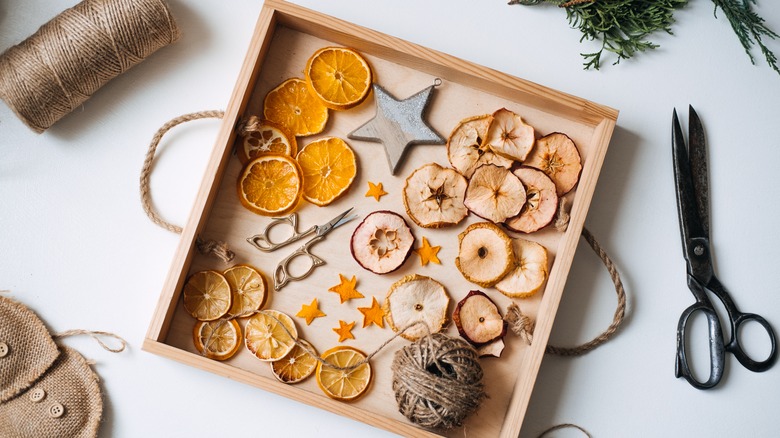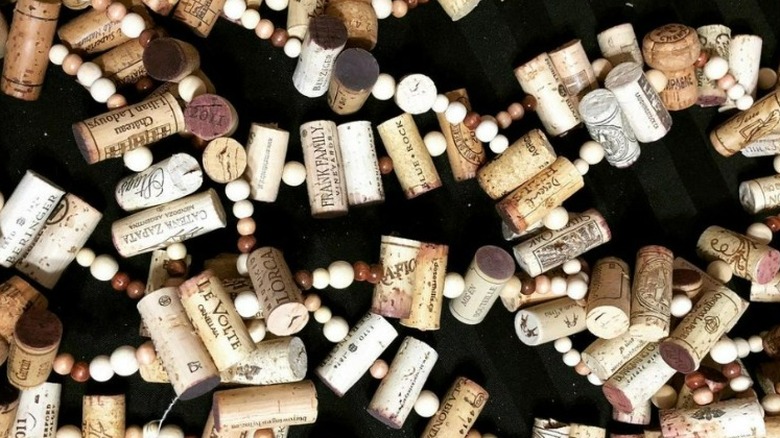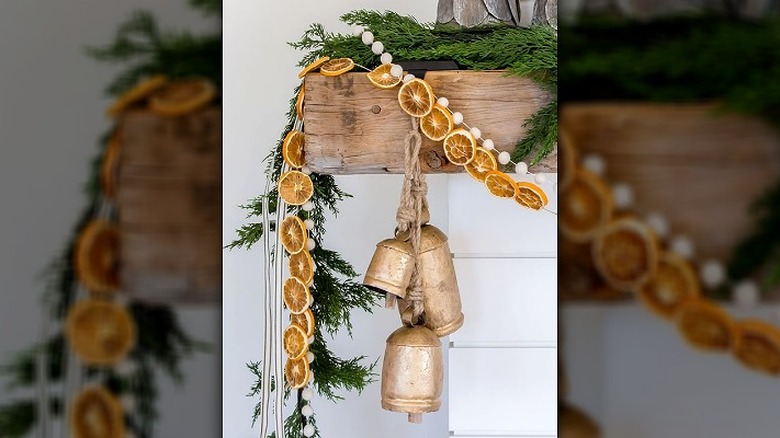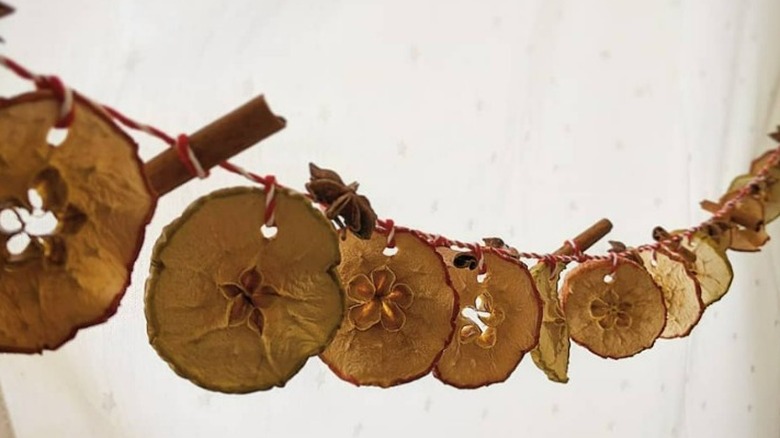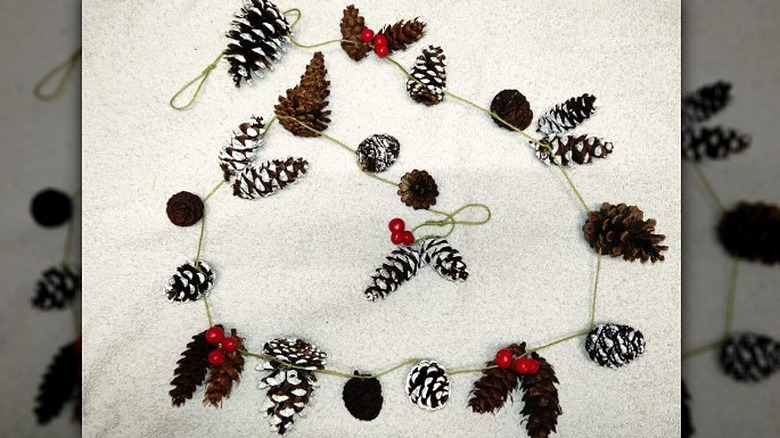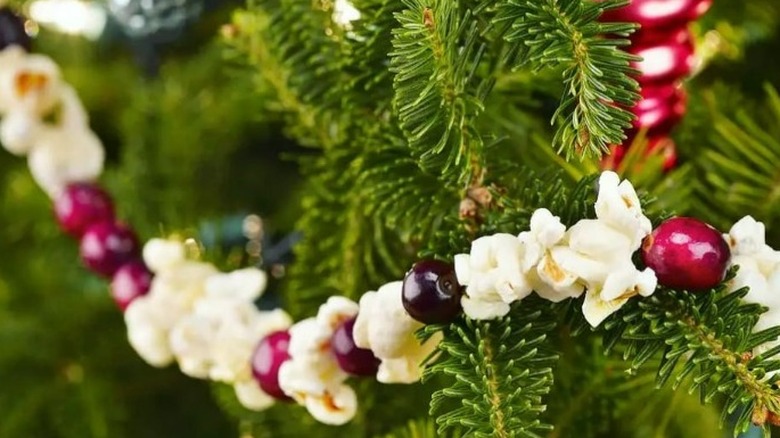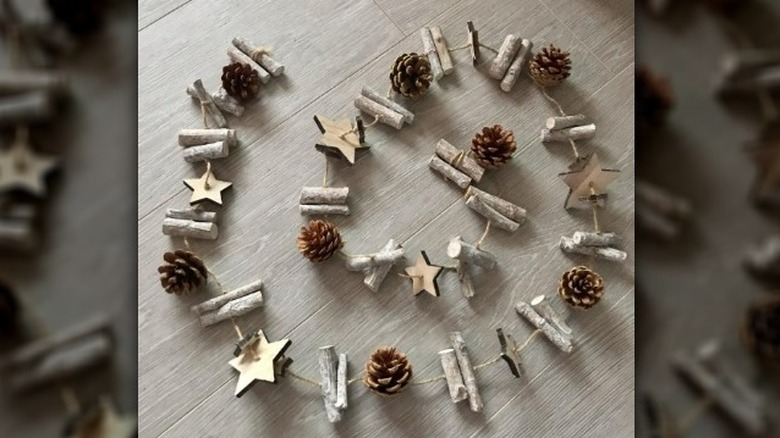How To Make Easy And Sustainable Holiday Garlands
The use of garlands can be traced back to Ancient Egypt, where people would bury their embalmed dead with flower garlands. Per Britannica, these woven garlands were meant to be a celebratory adornment for the deceased and were a symbolic offering of good luck in life after death. The Greeks and Romans also were privileged to use garlands as building and table décor, and in Hinduism, marigold garlands are commonly seen as offerings on statues of deities. But the Christmas garland, writes the Baker Design Group, is thought to have been brought over by the first American settlers. Money was scarce during the winter months. To help bring in some extra income, families would weave together pieces of nature and sell them to other family members, friends, and neighbors to supplement their limited funds. Thus, the Christmas garland was born.
Making your holiday garland is straightforward, entertaining, and super green. It doesn't require too much: just some string and one or two items. The art of making a garland can also be a somewhat meditative process. These are a few simple Christmas garland options to try out this holiday season because nothing says "crafty eco-warrior" like making your own earth-friendly Christmas décor.
Wine corks
If you're a vino lover, you probably have more than your fair share of wine corks lying around. It's not uncommon to see homes with giant containers of wine corks on display. According to WineBid, these can be serious wine collectors who want to memorialize the moment. Or they can be people who use the corks almost like diary entries, jotting down the date they enjoyed the bottle and the occasion. The problem with displaying corks in a vessel is you have to fish around if you want to find one.
Using wine corks in a garland is a great way to keep your memories more visually organized. There are a couple of different ways to build this garland. You can drill a hole through the cork, which takes some time but keeps it nice and secure. The other option is to use miniature screw eyelets, which you would affix to each end of the cork, via Instructables. If you're planning on displaying them for Christmas, add a bit of holiday flair by adding red, white, and green wooden beads, bells, and small snowflakes. Alternately, keep it neutral if you plan on keeping your cork garland up year-round. Making garlands with family and friends is also a great bonding moment, especially if there's wine.
Dried oranges
It might come as a surprise, but oranges are symbolically linked with the Yuletide season. Smithsonian Magazine explains that the 19th-century tradition of putting oranges in the toes of Christmas stockings is meant to represent good fortune. During the Great Depression, an orange was indeed a luxury item, so receiving one was like a Christmas miracle. An orange slice has an uncanny resemblance to a coin, so it only makes sense to hang a golden garland around the house or tree to bring prosperity.
To make these colorful, eco-friendly garlands, you'll need oranges, string, and spare time. After thinly slicing your oranges, place them between two paper towels to draw out any extra juices, notes The Toasted Pine Nut. Put the slices on a parchment paper-lined baking sheet and bake them at 200 Fahrenheit for three to four hours, flipping them over at the halfway mark. Once your oranges have cooled down, take a toothpick and poke little holes in them for your string. Add other Christmassy elements like pinecones, which represent regeneration, family, and enlightenment, via Symbol Sage or cinnamon (abundance and prosperity, per Well+Good) for some extra good tidings.
Dried apples and nuts
Have you ever received an orange and an apple in your Christmas stocking? That's because, along with oranges, apples also intertwined with the holiday season. Though apples tend to have more theological and religious-based symbolism, the fruit also represents Aphrodite, the Greek Goddess of Love, as well as the Norse Goddess of Lovers, Idunn, notes Good Luck Symbols. In China, apples are given as gifts on Christmas Eve because they represent peace.
Hanging dehydrated fruit décor around your home, especially during the holidays, adds a nice pop of color and infuses your space with positive vibes. Make sure you slice your apples horizontally through the middle. You'll see that the fruit has a star on the inside where the seeds are. Bake them at 200 Fahrenheit, writes The Happier Homemaker, and then poke a hole using a toothpick (just like the dehydrated oranges) to string them onto a cord of your choice. To add the unshelled nuts to your garland, you'll need a heavy-duty upholstery needle and a hammer, per Gardenista.
Cinnamon stick and pinecones
Cinnamon is one of the warmest, most inviting smells synonymous with the holidays, and it is Christmas in spice form, via Veecoco. The same can be said about pinecones. After all, when the supermarkets begin selling bags of cinnamon-infused pinecones, they're saying Christmas will be here in a month or so. Instead of buying into capitalism and purchasing premade cinnamon-laced room deodorizers, why not make your own? Even if you don't have pinecones in your area, you can still get cinnamon, and you can use your creativity or get inspiration from the other garlands on this list and make an option unique to your home.
Once you've sourced your pinecones, you will want to de-bugify them. Straight-out-of-nature cones can have mildew and bugs living in them, and those do not belong in your happy holiday home, writes Refresh Restyle. Once properly cleaned, you can keep your pinecones au naturel or add white earth-friendly paint to simulate snow. Grab some thematic string and start tying knots, creating your own pattern as you go. Soon you'll have a beautiful garland that you can reuse the following year or go in the compost when the season is over.
Popcorn
Popcorn might sound like a rather odd thing to hang around your home and especially on your Christmas tree, but this movie theater staple has been used for holiday decorating since the Victorian era, as noted on Yahoo. The first documented popcorn-decorated tree can be traced back to Williamsburg, Virginia, circa 1842, per the book "Christmas Past."
This super simple snack-style garland requires a lot of popcorn, some thread, a needle, and willpower. Homesteading notes that you should let your popcorn sit out for anywhere from 24 to 48 hours to keep it from crumbling. No one likes to eat stale popcorn, so it's less tempting to munch on while you're building. For a pop of color, add some cranberries or other fruit, which is the traditional German way of crafting one of these bad boys, per the craft blog Julie Blanner. A word of caution when working with cranberries. Remember to wear old clothes and keep a towel nearby because these tart berries can (and will) stain.
Just twigs
This is one of the more earth-centric and rustic garlands on the list, but it also uses the least components. All you'll need are scissors, as well as strings and sticks that are all relatively the same length. That being said, it's also a bit more tedious to build than the other garlands, so make sure you've got something streaming on your TV to keep your mind preoccupied or allow the process to put you into a meditative state.
You'll need to do a bit of recon for this one, which entails going outside and finding some branches or sticks of uniform size and thickness, per Funky Jun Interiors. The uniformity makes them easier to work with, but variety can also add a bit of character to your garland. Once you've collected around a dozen or more tree fingers, you'll want to cut each stick into three-inch pieces. Then comes the fun part. Working in small batches, tie a knot around one stick, add a twig, tie another knot, and so on. Once you've finished as many mini bundles as you'd like, tie them together for a lovely, farmhouse-inspired Christmas garland. Feel free to decorate it with cranberries and other holiday goodies.
